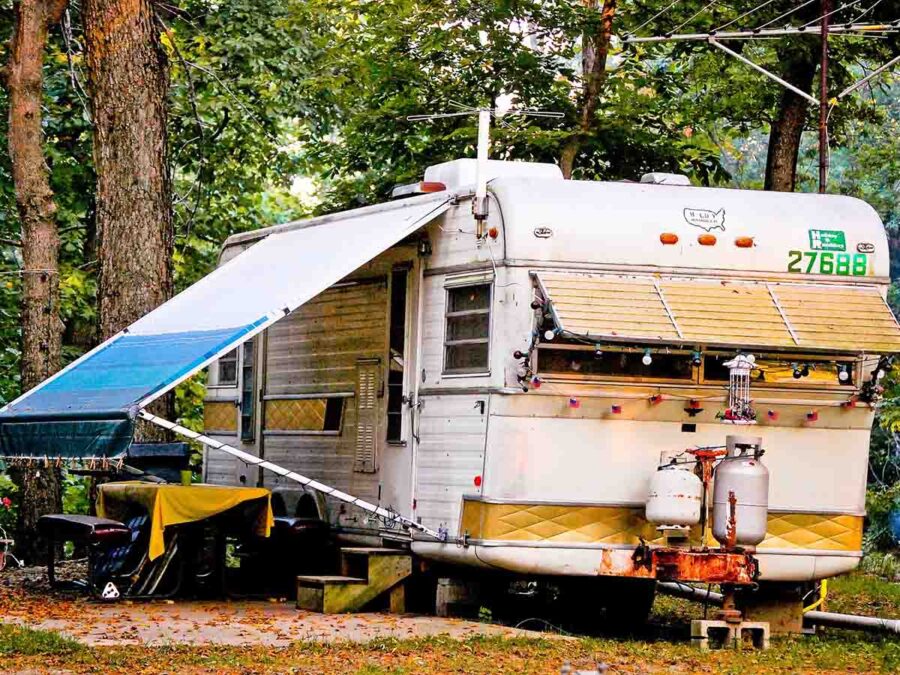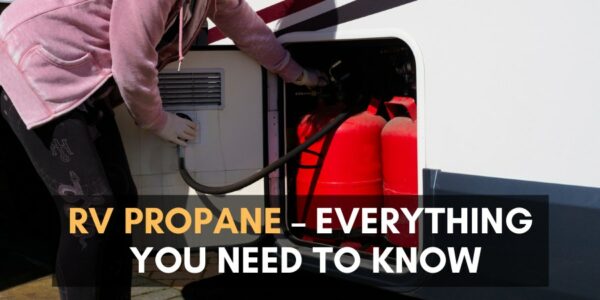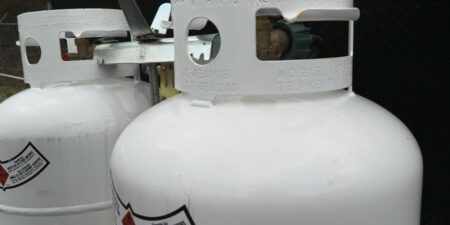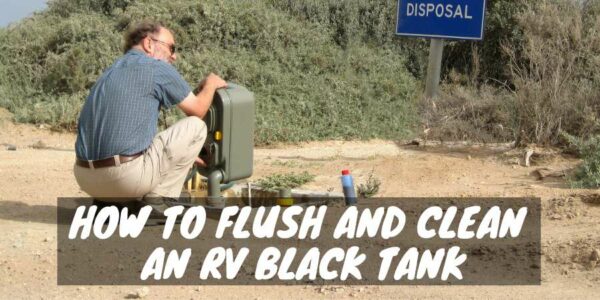Warm weather means plenty of grilling and camping, and portable propane tank sizes/gas is an affordable, clean-burning fuel for cooking, fire pits, generators, camping heaters, or running recreational vehicle appliances.
But portable propane tanks come in many sizes, so you may have questions about which tank is best for your needs.
That’s why this guide gives you all the answers about portable propane tank sizes and uses.
The more you know about portable propane tanks, the better equipped you’ll be to make all your camping and outdoor entertaining more enjoyable.
Portable Propane Tank Sizes
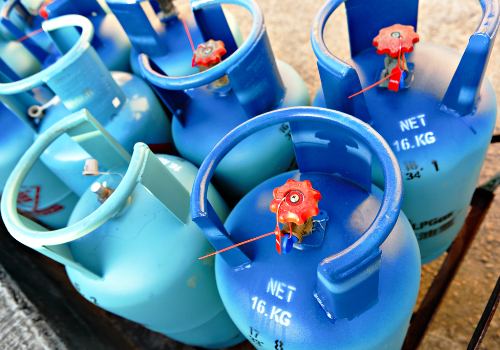
If you love to camp, grill, or RV, these are the most common portable propane tank sizes:
- 1 pound: Typically used for portable stoves, small grills, and camping lanterns. These are very lightweight and convenient for short trips.
- 5 pounds: A step up, suitable for more extended camping trips or for use with small to medium-sized grills.
- 10 and 11 pounds: These sizes offer a balance between portability and capacity, good for longer camping trips or more frequent grilling without being too heavy or bulky.
- 20 pounds: This is one of the most common sizes for backyard grills and standard RVs. It offers a good balance of capacity and portability.
- 30 pounds: Often used for larger RVs, these tanks provide a longer usage time, suitable for longer trips or if you have higher propane demands.
- 40 pounds: These are less common for casual use but can be found in settings where a significant amount of propane is needed but still within a portable range.
- 100 pounds: Though still technically portable, 100-pound tanks are quite bulky and heavy, often used for home heating, large RVs, or as a stationary source that can be connected to multiple appliances or for extended use.
A propane tank’s weight varies by size, as a gallon of propane weighs 4.2 pounds, and each metal canister adds additional weight to the total.
For example, a full 20-pound LP tank weighs around 36 pounds. So, the “pound” refers to the amount of gas that will fill a tank. But, again, this number is also a bit misleading, as it’s unsafe to fill a propane tank to 100 percent capacity.
Safety regulations require all portable propane tanks to be filled to no more than 80 percent of capacity to allow the gas to expand under hot conditions without blowing the tank apart from too much pressure.
Here is a breakdown of the common usage for each size of portable LP tank:
1-Pound Propane Tank
The 1-pound propane canister is the go-to solution to fire up small camping grills, burners, heaters, and lanterns. The tank is easy to slip into a backpack or storage bin, is lightweight, and is durable enough to withstand bangs and bumps without damage.
The canister screws directly onto the appliance, and the gas will dispense via a control knob on the item. However, you can purchase a hose and adapter to use it with other types of equipment.
Most 1-pound LP tanks come in a four-pack at camping or general merchandise stores. A single tank holds approximately 1/4 gallon of propane.
Please note that 1-pound canisters are not refillable, and you must toss them in the trash when empty.
5-Pound Propane Tank
The 5-pound propane tank is an ideal size for weekend camping trips or smaller gas grills where you need a longer run time but want to avoid packing and hauling around a heavier, larger tank.
The tank will attach via a hose and regulator to a grill or other LP-run camping equipment like a firepit, generator, light, or heater so you can enjoy everyday activities when shore power isn’t available.
You can refill 5-pound propane tanks, but you may need to take them to a certified LP service center to do so, as many campgrounds have difficulty knowing how to fill them. Expect this tank size to hold about 1.2 gallons of propane.
The runtime of a 5-pound portable propane tank can range from only two hours using a 60,000BTU heater to twenty or more hours running a lantern.
Do note that the tank’s cost is relatively high compared to more common-size propane tanks, but the convenience of the smaller, easier-to-tote canister is well worth it.
11-Pound Propane Tank
The 11-pound propane tank is not very common but is another option when you want to streamline your camping supplies to provide the power you need without extra bulk or weight. Most companies sell an 11-pound tank, while others offer a 10-gal propane tank but still note a 2.5-gallon capacity on the label.
The tank attaches to the appliance or equipment of your choice using a hose and is refillable at any certified LP service center. You can purchase the tank in a tall cylindrical shape or a “squatty” that is shorter and wider.
The runtime of an 11-pound portable propane tank is suitable for a 2-5 day camping trip and will hold around 2.5 gallons of propane.
20-Pound Propane Tank
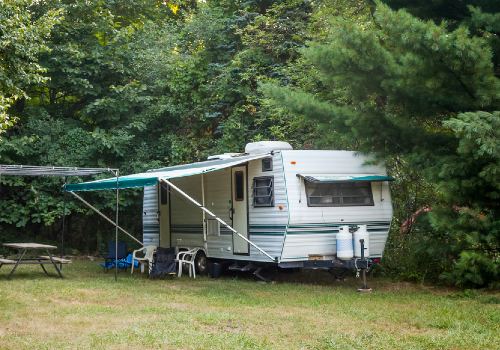
The 20-pound propane tank is by far the most common size people use for grilling, running RV appliances, or other equipment like gas generators or heaters.
The tank attaches to the equipment through a hose and holds enough propane to keep things running on extended camping trips or through many grilling sessions, so you aren’t constantly worrying about refills.
Many mid-size RVs have a mount or bay that holds one or two 20-pound tanks to run the fridge, stove, oven, furnace, and water heater.
You can find LP service centers or campgrounds that refill 20-pound tanks, or you can exchange an empty tank for a full tank at many gas stations, hardware stores, or places like Walmart.
Depending on usage, the runtime of a 20-pound portable propane tank can range from 10-30 hours of continual use.
30-Pound Propane Tank
The 30-pound propane tank is pushing the boundaries of an easily “portable” tank, as it will weigh around 55 pounds and is tall and bulky.
Most people only use the 30-pound LP tank for RV use or more permanent grill setups, but you can hook it to other propane-fueled appliances just as you would a smaller tank if you want longer runtime.
Refills are available at propane service centers or some campgrounds, but sometimes, you can find a 30 lb propane tank exchange location.
Depending on usage, the runtime of a 30-pound portable propane tank can range from about ten hours running a 70,000 BTU heater to over 60 hours on a 10,000 BTU grill.
40-Pound Propane Tank
The 40-pound portable propane tank size is an excellent choice for long-term use of grills or other camping gear like generators where you aren’t going to be moving the items or tank often.
The tank operates the same for filling and connecting to appliances or equipment using a hose with a regulator but will weigh around 72 pounds when full with 9.4 gallons of propane.
Some large RVs come with a 40-pound portable tank, but in general, this size is rare for use in camping situations.
Depending on usage, the runtime of a 40-pound portable propane tank can range from 25-70 hours.
100-Pound Propane Tank
The 100-pound propane tank is perfect for permanent outdoor gas grills or fire pits or for setting up long-term at a campsite or cabin. Many food truck owners also use this size tank to run grills.
The tank operates and connects like their smaller versions but holds 23.6 gallons of propane and weighs 170 pounds when full, so you’ll need a hand when taking it in for a refill. Many people with this size tank have an LP service company come to their location to fill the tank onsite.
Depending on usage, the runtime of a 100-pound portable propane tank can range from 11-85 days.
Portable Propane Tank FAQs
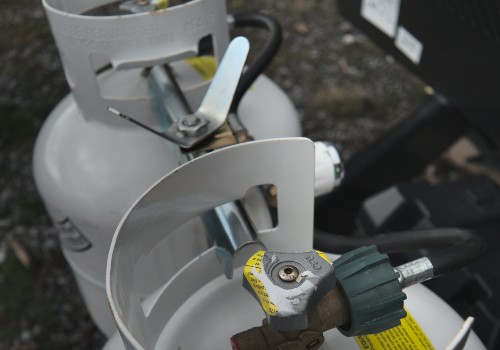
How Do I Know the Age of a Portable Propane Tank?
A propane tank should always be ASME certified and have a date code stamped into the metal collar of the canister.
The date on the tank will be the month and year of manufacture. Most will be two numbers each for the month and year with a dash in the middle, but some will have what appears to be a capital A between them.
Most portable propane tanks are safe for 12 years of use, and those in good condition can be recertified for five more years by a propane dealer. Recertified propane tanks will get a dated sticker.
However, rust, corrosion, dents, or other damage to the tank or fittings can make even a year-old propane tank unsafe for filling or use. If you see such concerns about your tank, you should exchange the tank for one that is in better condition or take it to a certified propane service to inspect it.
You’ll need to get a new tank if the technician refuses to fill it due to condition problems or if it’s expired when taking it for a refill. Don’t risk anyone’s life by insisting someone fill a questionable propane tank; explosions and fires do happen.
EXPERT TIP: We find it common to get out-of-date or rusty tanks from propane-exchange cages. Often, these tanks are repainted to look new, with a new plastic sleeve to hide any corrosion, so you don’t think to check the date.
Want to Connect With a Community of Over 1,078 RV Enthusiasts?
Other times, the tanks are repainted so much you can’t read the date, but when you take it for a refill, the technician refuses to fill it. Take your time when selecting a tank from a cage; don’t just let store personnel hand you a tank without inspecting it for damage, rust, or a valid, readable date.
How Long Does 1 LB Propane Tank Last?
Depending on usage, the runtime of a 1-pound portable propane tank can range, on average, between two to six hours.
For example, a tank you connect to a camp grill running on high heat should take about 1.5 hours to empty. Or, you can run a lantern on low for many hours before the tank runs dry.
How Long Can You Store Propane?
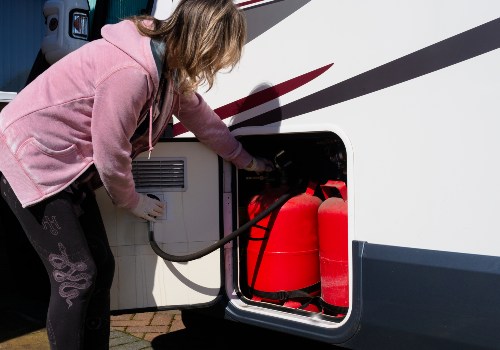
If stored under proper conditions, propane can last indefinitely as the gas does not degrade over time. This feature is another reason propane is popular as fuel for many types of equipment and camping gear.
The proper way to store a portable propane tank is to store it upright and secure it from tipping or excessive motion so the relief valve remains in the vapor space at the top of the tank. Then, if too much pressure builds up inside the tank from heat, the valve will work properly to prevent an explosion.
Keep all propane tanks outdoors but undercover to protect them from the elements.
Lastly, never store propane tanks near a furnace, water heater, fireplace, or other sources of an open flame.
Where to Store Small Propane Tanks?
The best place to store small propane tanks is outside. However, many camping enthusiasts pack 1-pound canisters into a vehicle or RV storage bay without issue.
People should not store larger tanks in a shed or garage because a gas leak can build up in an enclosed space, and one spark can ignite a fire.
If possible, keep a portable propane tank in a shady or cool location, out of the rain, snow, or humid conditions where moisture will rust the tank or fittings.
Are Propane Tanks Safe in the Sun?
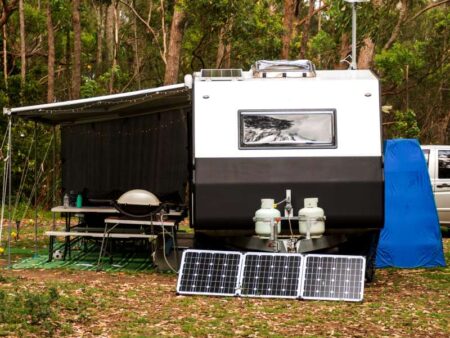
Propane tanks can withstand limited exposure to the elements and bumps and vibrations of transport, but they cannot handle excessive heat from sitting under the direct hot sun for days.
Heat expands the gas in the tank, which builds up pressure inside, causing the relief valve to release some propane into the air as a safety precaution. Not only does this waste your propane, but it could also collect around the tank and ignite if a flame or spark gets too close.
Temperatures over 120°F are dangerous, so keep any portable propane tank shaded and well-ventilated during storage.
Can You Lay a Propane Tank on Its Side?
Never lay any propane tank on its side, as the design features a valve and floats near the top where it gets filled. Tipping or laying the tank down can expose the valve to the liquid propane, not just the vapor as intended, causing this float to stick.
A stuck valve means you will not get the propane to dispense when you want to use it, nor will you be able to fill the tank if it sticks while bringing it in for service.
A reputable LP service technician will inform you of proper transporting procedures. In general, always stand a tank upright in your vehicle and strap it tightly to keep it that way until you reach your destination.
Can Propane Tanks Be Used Laying Down?
You cannot use a portable propane tank made for vertical dispensing laying down because the valve that allows the propane vapor to pass through will malfunction when liquid propane touches it.
However, you can purchase portable propane tanks with a design that allows for safe horizontal placement and use.
Portable Propane Tank Wrap-Up
With some know-how, it’s easy to get the best portable propane tank for your needs, whether you’re using it to grill burgers in the backyard or keep your RV or tent heated during cool-weather camping trips.
We hope this guide teaches you how to select, transport, store, and refill propane tanks so you can enjoy years of stress-free use!
Propane Safety Tips (Video)
"Man cannot discover new oceans unless he has the courage to lose sight of the shore."
-- Andre Gide

